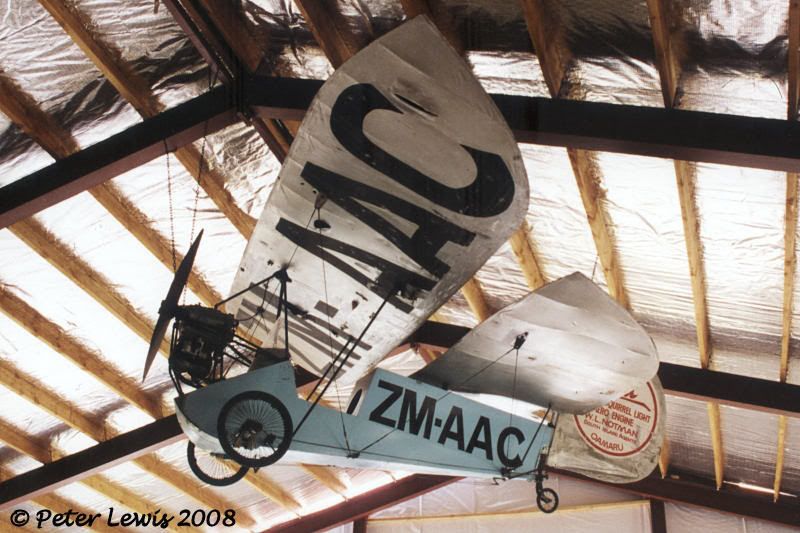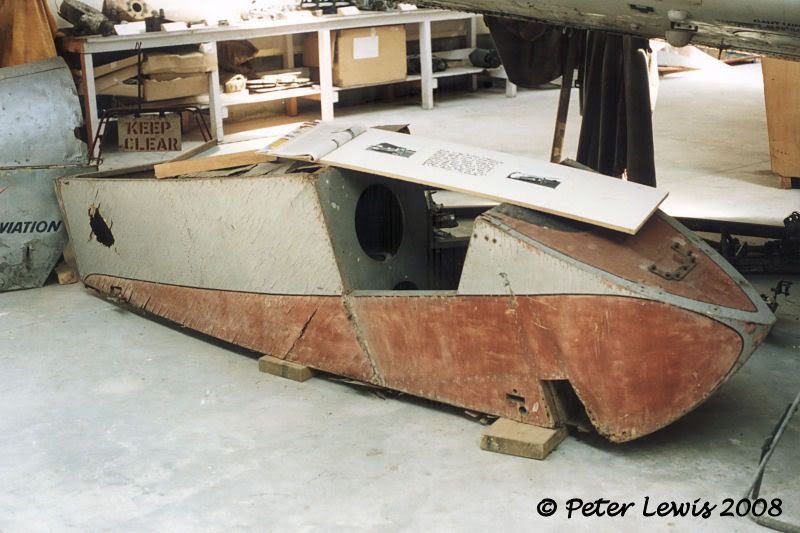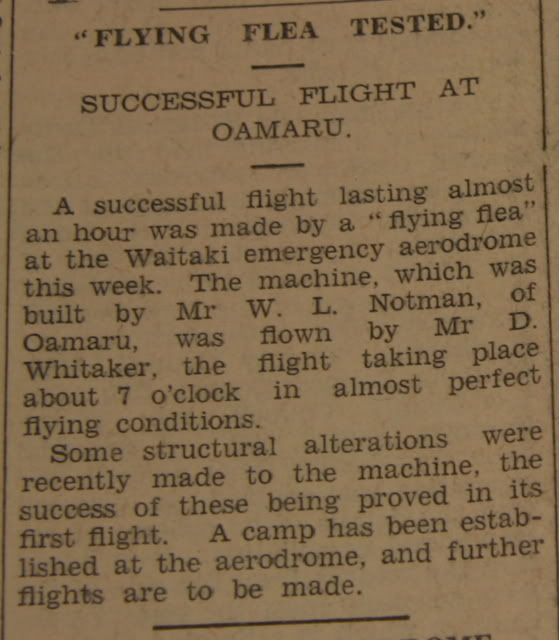|
|
Post by Dave Homewood on Jul 16, 2008 11:25:06 GMT 12
That is a fantastic account of what must have been a highly amusing day for someone as experienced as Clouston. It would make the wonderful subject of a manic piece of aviation art.
|
|
|
|
Post by Peter Lewis on Jul 16, 2008 22:06:39 GMT 12
Was that flight unlawful (apart from being unregistered?) Without a doubt. However, it was Ken Cox's first flight in the aircraft, and he was killed in the ensuring crash, so there was not a lot that could be done about it. This Flea was indeed the Barnard Owen one, which was built by Owen & Arthur Jackson in 1936. Interesting to hear about John Neave's involvement, I knew its first flight was at Lake Ellesmere, but I've never heard of a "synchroplane " before - any further details? Stu - the description of the air meet certainly sounds hilarious, but seems to be a factor of the inexperience of the people involved rather than design deficiencies of the Flea itself. Remember that in the 1930s, the average income earner had no hope of direct involvement in aviation, and Mignet offered the only route that these people had to actually fly. His activities at least laid the foundation for the success of the Turbulent in the 1950s and the 'home built/sport aviation' system that we have today. Reverting to NZ Fleas, I do have photos of the following: ZM-AAC at Wanaka 2002:  The unregistered McMillan (later Brewster) Flea, Taranaki museum 1996:  The Flea at Ashburton aviation museum (is this one of those listed above, or another one?):  I also have pics of ZM-AAA (the MoTAT one) but can't find them right now. My listing covers those Fleas that actually flew or attempted to do so. Phillip Treweek's Flea page talks of 'twelve know projects', but this may refer to uncompleted examples as well as those above. If you have any more Flea info, you are welcome to contribute it to the discussion. |
|
|
|
Post by Dave Homewood on Jul 16, 2008 22:46:39 GMT 12
Were the Fleas officially banned from flight in NZ like they were in other countries? If so, when?
Did the number of aircraft that were built that simply couldn't fly, or attempted to and killed the pilots, must have really given the whole early homebuild fraternity rather a stima among more serious aviators as being amateurs and nutcases?
|
|
|
|
Post by stu on Jul 17, 2008 10:35:20 GMT 12
Stu - the description of the air meet certainly sounds hilarious, but seems to be a factor of the inexperience of the people involved rather than design deficiencies of the Flea itself. Remember that in the 1930s, the average income earner had no hope of direct involvement in aviation, and Mignet offered the only route that these people had to actually fly. His activities at least laid the foundation for the success of the Turbulent in the 1950s and the 'home built/sport aviation' system that we have today. Agreed and, just in case I'm giving the wrong impression, I'm not on an anti-Flea campaign. My previous post was just there as a bit of a light-hearted aside. I have read - somewhere - about how difficult they were to fly and as a result, I feel that the reputation they earned was due to their popularity amongst many non, and less than experienced, pilots when they probably needed somebody with a reasonable amount of skill at the helm. Also, the sheer number of Fleas that were around when the craze was in full swing would have no doubt lead to a proportionally higher number of accidents being reported, especially considering the skills, or lack thereof, of many enthusiastic would-be pilots. Cheers, Stu.  |
|
|
|
Post by Dave Homewood on Jul 17, 2008 10:42:46 GMT 12
So they're the Robinson R-22 of their day then? ;D
|
|
|
|
Post by nzompilot on Jul 17, 2008 12:06:32 GMT 12
From Wings April 1978  |
|
|
|
Post by nzompilot on Jul 18, 2008 14:02:36 GMT 12
Whilr researching something else for Dave, I came across this article in the Marlborough Express Saturday November 12 1938  |
|
|
|
Post by Peter Lewis on Jul 19, 2008 12:06:32 GMT 12
Now thats an interesting cutting from 1938, presumably referring to ZM-AAC.
I have "F/f Alma airfield, Oamaru, 15May36 to 1000ft by David Whitaker. Several flights over about eight months."
So maybe the "first flight" date mentioned here - November 1938 - refers to the first flight after some structural alterations.
Anyone get any gen to confirm or refute this?
|
|
|
|
Post by Dave Homewood on Jul 19, 2008 13:00:12 GMT 12
I think from the text you'd be right in thinking that Peter. Perhaps they too converted it into a "synchroplane "?  I assume that a synchroplane has flapping wings? |
|
|
|
Post by shorty on Jul 19, 2008 13:09:35 GMT 12
Flapping wings are ornithopters. I assumed a synchroplane has both wings moving either together or perhaps in different angles but together rather than being able to move them seperately.
|
|
|
|
Post by sleemanj on Jul 19, 2008 15:28:21 GMT 12
I assume that a synchroplane has flapping wings? The Flea had (has) an unusal control method of moving the entire forward wing, kind of like an ENORMOUS canard. Like shorty, I'd expect that a "synchroplane" in this context moves both wings in the same manner. It sure would be interesting to fly a synchroplane, I bet the stall characteristics would be rather abrupt to say the least! |
|
|
|
Post by Dave Homewood on Jul 19, 2008 15:46:34 GMT 12
How to make a dangerous aircraft more dangerous... ?
|
|
|
|
Post by FlyingKiwi on Jul 19, 2008 20:00:23 GMT 12
Dave, one wonders if the Flea had remained popular how long it would be until someone would have attempted to fit one with a jet engine.  |
|
|
|
Post by Bruce on Jul 19, 2008 22:55:06 GMT 12
I know just the guys who would have tried....  |
|
|
|
Post by Dave Homewood on Jul 19, 2008 23:50:13 GMT 12
Mythbusters? ;D
|
|
|
|
Post by stu on Jul 20, 2008 16:31:08 GMT 12
|
|
|
|
Post by Dave Homewood on Jul 21, 2008 13:41:41 GMT 12
I asked on the PlaneTalk Forum if anyone knew what exactly a synchroplane was and got a great answer thus: (go to the link to see a great cartoon too) forum.planetalk.net/viewtopic.php?p=58160#58160Hi Dave, I can't find the copy now, but a reference was made to the "Synchroplane" conversion in a late 1930s copy of Popular Flying. The theory was that by having the rear wing of the Flea hinge in a similar manner to the front wing and no doubt linking both the movements to the stick, that it would eliminate the aerodynamic interference between the two wings. I hadn\'t realised till now, that anyone was daft enough to put the theory into practice! Another way around the problem was to extend the rear fuselage and add a tailplane. When Cecil Latimer Needham tried this the engine couldn't overcome the drag of all the mainplanery. So he extended the front wing, removed the middle wing .....and the result was the Luton Minor!! |
|
|
|
Post by Dave Homewood on Jul 21, 2008 14:10:33 GMT 12
Stu, that film footage was interesting, I had no idea people had been game enough to cross the English Channel in these Heath-Robinson style contraptions, nor thatthey could acheive 6000 feet of altitude. I was also expecting Mr Cholmondley Warner and Grayson to pop up and say they were not for ladies.  |
|
acer
Sergeant

Posts: 18 
|
Post by acer on Jul 21, 2008 15:49:03 GMT 12
|
|
|
|
Post by Peter Lewis on Jul 21, 2008 23:53:30 GMT 12
The Flea shown in the video - G-ADMH - was the first one to get airborne in the UK. S V Appleby took it into the air 14th July 1935, and the crash at Heston as shown took place on the 25th.
After restoration, this Flea flew across the channel to France and returned at a later date. Depending on the engine fitted, the Flea had a range of around 200 miles at 60mph, so this was well within capabilities.
The nose-down crashes took place over a few months from May 1936, and the conclusive wind-tunnel tests that confirmed the control problem were carried out late that same year.
A Flea with a jet would probably have had the same sort of capabilities as the BD5J!
|
|

